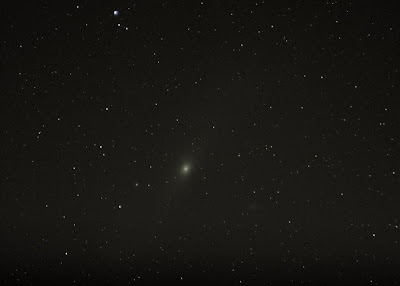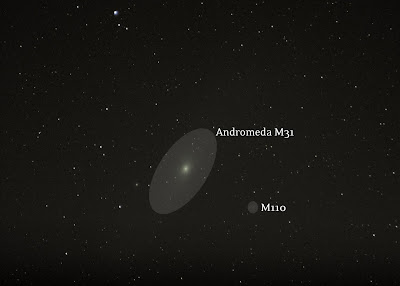I want to try re-stacking my batch with some different parameters, and I'll eventually re-shoot Andromeda without the Moon glaring at me.
 |
| 318 light frames, ISO 1600, 300mm, 1.6 sec each, stacked in DSS, adjusted in Photoshop |
 |
| Labeled version of the same picture above |
 |
| Planning my shot earlier last night, view generated in Stellarium |
The hardest part was FINDING the faint gray blur in the sky in the first place! I turned my shutter speed down to 8 seconds to try to find a smear in the general area where I thought it would be. Nothing. Next I tried going from landmark to landmark - leapfrogging from the Moon to surrounding stars to the general area where I thought it should be.
 |
| 300mm, 8 sec at ISO 1600 used to locate Andromeda for the first time |
I saw a rusty orange smear on the 8 sec exposure. Having never seen Andromeda "in person" before, I had to assume that this was the real thing. 300+ exposures later, manually tracking using the visible stars as a reference, I stacked my batch and came out with something pretty cool (for a newbie). Next time finding it should be a breeze. It's fun knowing that I know where to look, or that I could show off by pointing it out to someone :)
I get a little blown away thinking about the light coming from ANOTHER GALAXY and landing in the back of my camera in the courtyard of my apartment complex - and the light that must surely be landing on me as well. It's kinda spiritual in an atheist way.
Update 1-21-2013: I did another pass at stacking in DSS and used Median Kappa Sigma (whatever that is!). I wanted to see if there was any more data hiding in there, so I really blasted it out with levels and contrast. I think dust trails are slightly more visible. I think this set is about maxed out, I need to try again from a darker sky and shoot for 400 subs.
 |
| Re-stacked same image set, blasted out the levels and contrast in Photoshop |
No comments:
Post a Comment